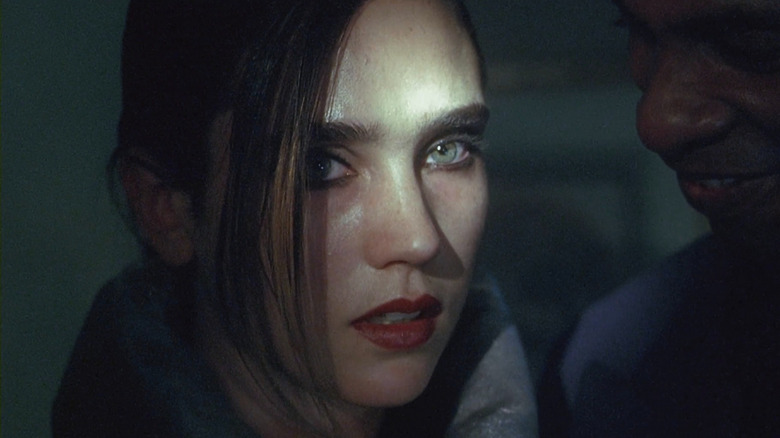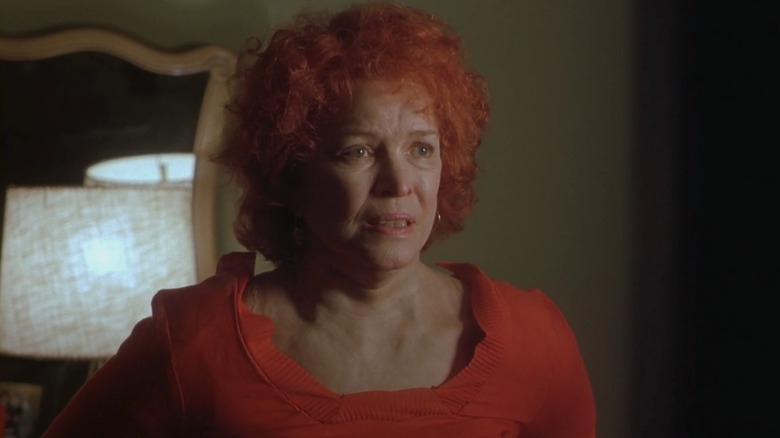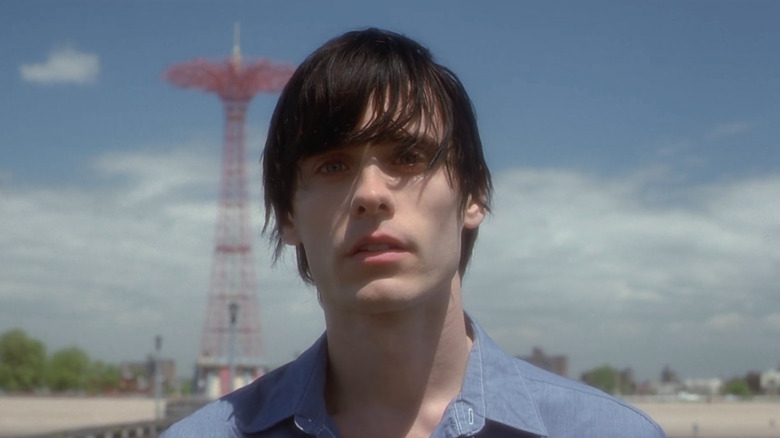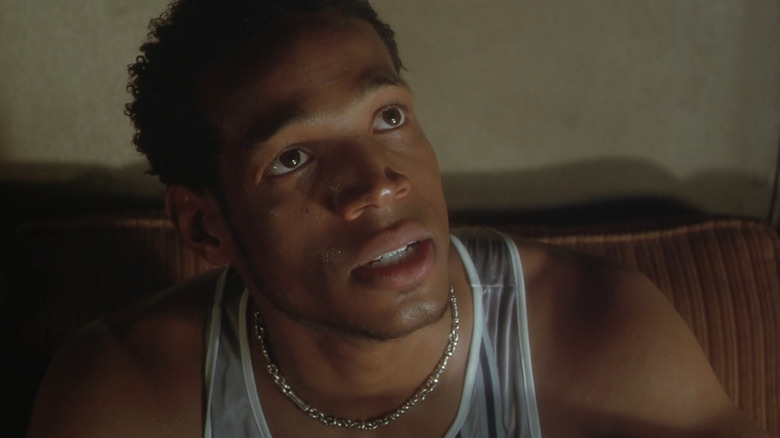Requiem For A Dream Ending Explained: The Many Faces Of Addiction
Anything can be an addiction. People sometimes casually throw around the word "addicted" when talking about shows they're hooked on and other likes and loves, but in "Requiem for a Dream," television is but one of many things that can be habit-forming for humans in all the wrong ways. Darren Aronofsky's 2000 film descends into a cacophony of cross-cutting and nightmarish images as its four central characters plunge deeper into addiction and self-destruction. The ending is an assault on the senses that leaves the viewer reeling, and 20-plus years have not diluted its power.
In the Catholic Church, a requiem is a Mass for the dead, with Mozart's "Requiem," as seen in "Amadeus," for instance, being the music that would accompany such a Mass. This frames the title of "Requiem for a Dream" as a more elegant spin on "Death of a Dream." Co-written by Aronofsky and Hubert Selby, Jr. and based on Selby's novel, the film uses heroin and amphetamine dependency to depict, more broadly, how any form of addiction can derail a person's life and turn dreams to delusions.
Ellen Burstyn gives a powerhouse, Oscar-nominated performance as Sara Goldfarb, an aging widow with an empty nest who latches onto the idea of losing weight and appearing on TV as something that will give her life meaning. While watching her favorite self-help infomercial/game show, she receives a literal phone call to adventure, telling her she's "already been chosen" as a show contestant.
As yet, no drugs are involved in Sara's storyline, which separates her from her son, Harry (Jared Leto), and his girlfriend, Marion (Jennifer Connelly), and friend Tyrone (Marlon Wayans). As the movie progresses, however, the lines between her and them and the audience's own possible everyday addictions grow increasingly blurred. Spoilers follow.
Drugs of choice
"Requiem for a Dream" ends with Sara, Harry, Marion, and Tyrone curled up in the fetal position on separate beds, couches, and cots, as if to retreat to the safety of the womb. Sara is in a psych ward, Harry is in the hospital, Marion is left traumatized, and Tyrone is in prison, while all their dreams have fallen by the wayside. Each character has their drug of choice, but the end result for all of them is the same.
This is a world where everyone has an addiction to something. Christopher McDonald's infomercial guru, Tappy Tibbons, says sugar was his medicine. "It nurtured my spiraling brain," he tells his at-home viewers and live studio audience. Prior to her downward spiral into amphetamine psychosis, Sara had been one of the viewers. Earlier in the film, Harry paints her relationship with TV as one that is not so different from his own relationship with heroin. He says to Marion, "What's her fix? Television, right? I mean, if ever there was a TV junkie, it's the old lady."
We're elsewhere told that Keith David's character, Big Tim, is "hooked on p****" instead of drugs, implying he has a sex addiction. The movie opens with Harry stealing Sara's TV and him and Tyrone wheeling it across Coney Island to pawn it for drug money. Later, when Harry pays Sara another visit at her Brighton Beach home, he recognizes the telltale signs of addiction in her with the way she's hyperactive and grinding her teeth.
This is a crucial scene where Sara admits that her dream stems from loneliness and a desire to be seen. The idea of fitting into her old red dress, being on television, seen by "millions of people," is her "reason to get up in the morning."
The dream at the end of the pier
Sara pins all her hopes on her dream of 15 minutes of TV fame, while Harry and Tyrone have their own warped dream of being successful drug dealers instead of just users. "This is our chance to make it big," Harry says as they begin to fill a shoebox with cash. Tyrone fantasizes about making his mother proud, and Harry wants to help Marion realize her dream of doing fashion designs by opening her own store. He has a recurring vision of walking toward Marion at the end of a pier; it suggests the dream is always out of reach and can itself be an addiction.
In the same way Sara experiences hunger cravings as she embarks on her crash diet with prescription pills, Harry, Marion, and Tyrone have formed a physical dependency on heroin that keeps them dipping into their stash and puts them in desperate straits when the local supply dries up. Throughout the movie, Darren Aronofsky, cinematographer Matthew Libatique, and editor Jay Rabinowitz use a variety of tricks like split screen, fast cuts, and spinning God's-eye shots to show their hyperkinetic state of mind.
In one scene, Sara's hallucinations play like a cross between "Ringu" and "The King of Comedy," as she sees Tappy and an idealized guest-of-honor version of herself cross over from the television into her living room. Her woman-eating fridge drives her out of her apartment and into the streets, with her trip to the casting agency serving as a reality check that shows just how far gone she is. At the same time, Harry has neglected the gangrene on his arm, so Tyrone is shocked when they pull over on their drug run to Florida and he sees how bad it has gotten.
Dopamine dangers
Each character in "Requiem for a Dream" is dehumanized as they reach rock bottom. Marion sells her body to finance her drug habit, becoming a sex object for a circle of men at a wild party. Sara gets manhandled and force-fed by orderlies as they discuss gambling (yet another addiction) and put her through electroshock treatments. Harry has his arm amputated, while Tyrone is subjected to racist abuse from prison guards. (Hubert Selby cameos as the one ranting about "New York dope fiends.")
"Requiem for a Dream" hit theaters in 2000, before the rise of social media, and its theme music, "Lux Aeterna" by Clint Mansell, has often been used in movie trailers. Even today, you don't have to be a drug user to see yourself in the film's characters or recognize the dangers things besides narcotics can pose.
Early in the movie, we see Sara eating chocolate, which can trigger brain chemicals like serotonin and dopamine that make a person feel good. It's just one example of a potential addiction that surrounds us. Facebook's first president, Sean Parker (played by Justin Timberlake in "The Social Network"), revealed that the social media platform was designed to take advantage of a "vulnerability in human psychology" and give people "a little dopamine hit" every time they receive a like or comment.
In "Requiem for a Dream," each character is left a moribund shell of a person, with Harry falling backward off the pier into a black abyss and Sara escaping into a fantasy where he is successful, and she has his love and everyone's adoration. The ending is not a happy one, but it functions as a cautionary tale about wasted lives and the perils of losing one's hopes to addiction in whatever it form it might take.



